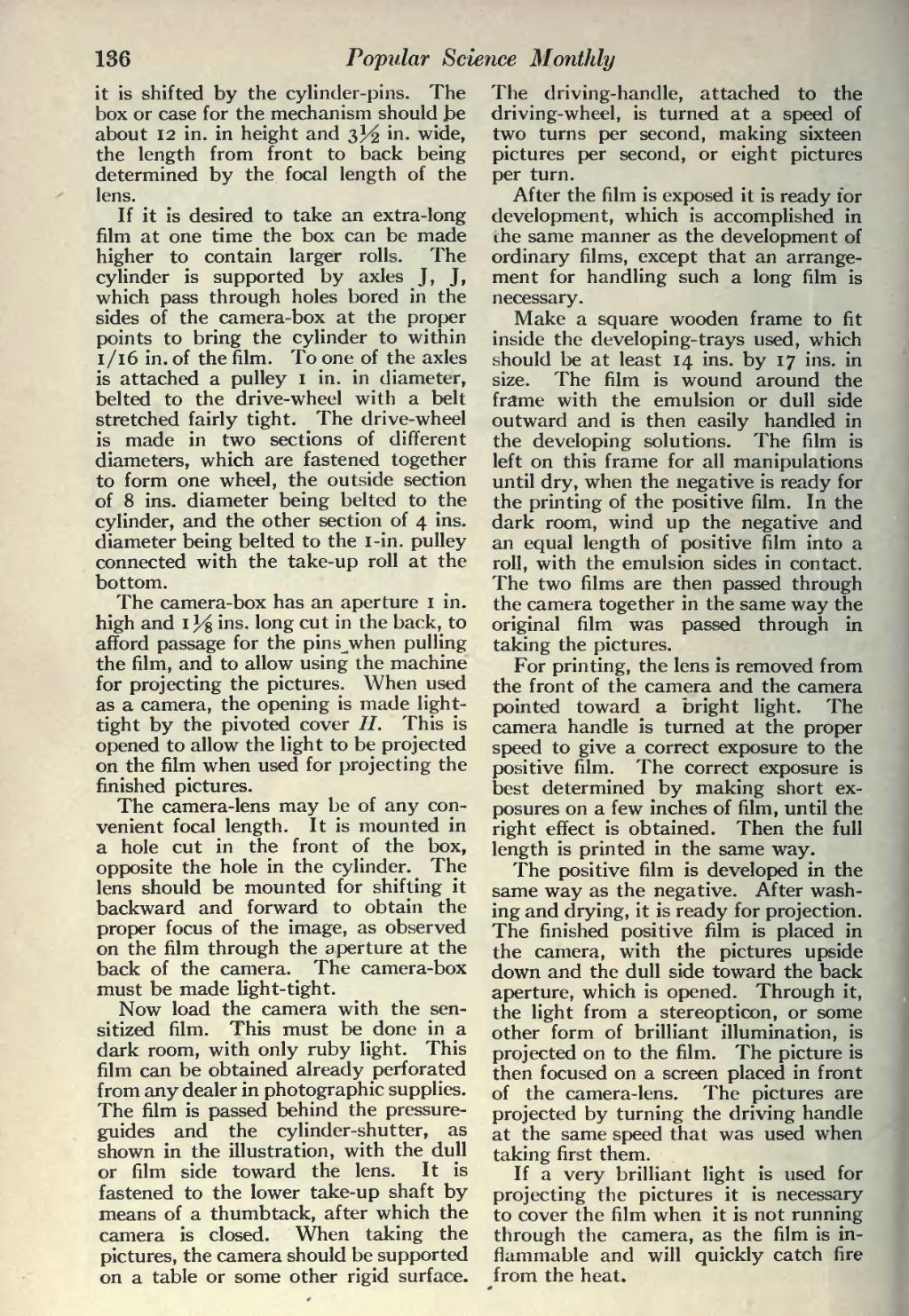it is shifted by the cylinder-pins. The box or case for the mechanism should be about 12 in. in height and 3½ in. wide, the length from front to back being determined by the focal length of the lens.
If it is desired to take an extra-long film at one time the box can be made higher to contain larger rolls. The cylinder is supported by axles J, J, which pass through holes bored in the sides of the camera-box at the proper points to bring the cylinder to within 1/16 in. of the film. To one of the axles is attached a pulley 1 in. in diameter, belted to the drive-wheel with a belt stretched fairly tight. The drive-wheel is made in two sections of different diameters, which are fastened together to form one wheel, the outside section of 8 ins. diameter being belted to the cylinder, and the other section of 4 ins. diameter being belted to the i-in. pulley connected with the take-up roll at the bottom.
The camera-box has an aperture 1 in. high and 1⅛ ins. long cut in the back, to afford passage for the pins when pulling the film, and to allow using the machine for projecting the pictures. When used as a camera, the opening is made light-tight by the pivoted cover H. This is opened to allow the light to be projected on the film when used for projecting the finished pictures.
The camera-lens may be of any convenient focal length. It is mounted in a hole cut in the front of the box, opposite the hole in the cylinder. The lens should be mounted for shifting it backward and forward to obtain the proper focus of the image, as observed on the film through the aperture at the back of the camera. The camera-box must be made light-tight.
Now load the camera with the sensitized film. This must be done in a dark room, with only ruby light. This film can be obtained already perforated from any dealer in photographic supplies. The film is passed behind the pressure-guides and the cylinder-shutter, as shown in the illustration, with the dull or film side toward the lens. It is fastened to the lower take-up shaft by means of a thumbtack, after which the camera is closed. When taking the pictures, the camera should be supported on a table or some other rigid surface. The driving-handle, attached to the driving-wheel, is turned at a speed of two turns per second, making sixteen pictures per second, or eight pictures per turn.
After the film is exposed it is ready for development, which is accomplished in the same manner as the development of ordinary films, except that an arrangement for handling such a long film is necessary.
Make a square wooden frame to fit inside the developing-trays used, which should be at least 14 ins. by 17 ins. in size. The film is wound around the frame with the emulsion or dull side outward and is then easily handled in the developing solutions. The film is left on this frame for all manipulations until dry, when the negative is ready for the printing of the positive film. In the dark room, wind up the negative and an equal length of positive film into a roll, with the emulsion sides in contact. The two films are then passed through the camera together in the same way the original film was passed through in taking the pictures.
For printing, the lens is removed from the front of the camera and the camera pointed toward a bright light. The camera handle is turned at the proper speed to give a correct exposure to the positive film. The correct exposure is best determined by making short exposures on a few inches of film, until the right effect is obtained. Then the full length is printed in the same way.
The positive film is developed in the same way as the negative. After washing and drying, it is ready for projection. The finished positive film is placed in the camera, with the pictures upside down and the dull side toward the back aperture, which is opened. Through it, the light from a stereopticon, or some other form of brilliant illumination, is projected on to the film. The picture is then focused on a screen placed in front of the camera-lens. The pictures are projected by turning the driving handle at the same speed that was used when taking first them.
If a very brilliant light is used for projecting the pictures it is necessary to cover the film when it is not running through the camera, as the film is inflammable and will quickly catch fire from the heat.
